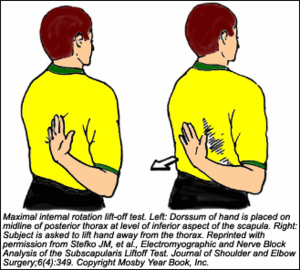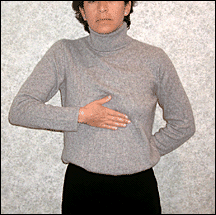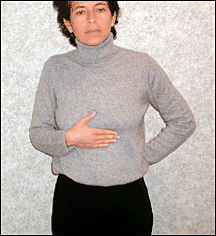The lift-off test has replaced the above-mentioned test; the patient lifts the dorsum of the hand to the position of the mid-lumbar spine, then attempts to lift the dorsum of the hand off of the back. This requires the ability of the patient to maximally internally rotate the shoulder, which is not always possible, due to shoulder pain or tightening of the posterior shoulder capsule. The test is positive if the patient cannot lift the hand off the back, or if he or she lifts the hand by extending the shoulder or elbow. Absolute loss of strength may indicate a rupture or neurological involvement, while diminished strength may be due to pain inhibition or actual weakness.
Takish, et al.,1 compared the lift-off test to the belly-press test, performed with the standing patient's hand against the upper abdomen, just under the xyphoid process.
The patient is asked to press maximally into the abdomen by internally rotating the shoulder. The test is positive if the patient flexes the wrist and adducts and extends the shoulder, instead of internally rotating the shoulder.
Most of the time, a patient with a painful shoulder will find it easier to perform the belly-press test than the lift-off test. Both tests are equally accurate, based on EMG evaluation, but there is a difference between the two with respect to testing the strength of the upper and lower portions of the subscapularis muscle. The subscapularis muscle is innervated by at least two separate nerves, and the EMG activity of the upper and lower portions are different, depending on the position of shoulder rotation.2 In the Takish, et al. study, the lift-off test created more activation of the lower subscapularis, while the belly-press test created more activation of the upper subscapularis. The reason for this difference is that the belly-press test requires 45 degrees of shoulder abduction.1 During a pitching motion, with the arm at approximately 90 degrees, there is greater electromyographic (EMG) activity of the upper subscapularis muscle.3
Therefore, these two tests can be used both to test the strength of the subscapularis and to distinguish between the functionally independent upper and lower portions of the muscle.
References
- Takish JM, Decker MJ, Ellis HB. The belly-press test for the physical examination of the subscapularis muscle: Electromyographic validation and comparison to the lift-off test. J Shoulder Elbow Surg 2003;12:427-30.
- Kadaba MP, Cole A, Wootten ME, et al. Intramuscular wire electromyography of the subscapularis. J Orthop Res 1992;10:394-7.
- DiGiovine NM, Jobe W, Pink M, Perry J. An electromyographic analysis of the upper extremity in pitching. J Shoulder Elbow Surg 1992;1:15-25.
Warren Hammer, MS, DC, DABCO
Norwalk, Connecticut
Click here for previous articles by Warren Hammer, MS, DC, DABCO.








